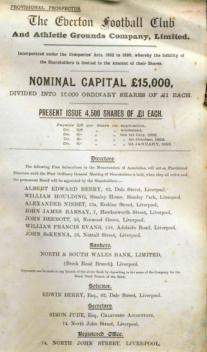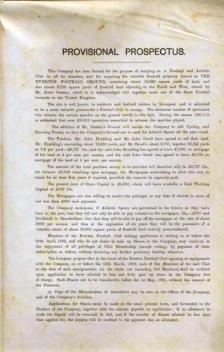Articles
1891-1892: A new perspective on the birth of Liverpool FC
This is the first chapter in Liverpool FC's history where we bring forth a new perspective on the split between

In the year of our Lord eighteen ninety and two
John Houlding evicted the blues
From their Anfield abode on the Walton Breck Road
He was tired of seeing them lose
A bank that held nothing but zeros
But Houlding instead built a team dressed in red
Liverpool his Anfield heroes
John Houlding (to the tune of Irish Rover)
Brewer John Houlding, who was Everton's president, was instrumental in renting a new land for Everton to play on between Anfield Road and Walton Breck Road on which Everton made their debut on 28 September 1884. Everton’s new home simply became known as Anfield after the district it was situated in. Joseph Orrell Jr., who inherited the land from his father in 1883, put it up for sale in 1885. Houlding bought Anfield from Joseph for 5,228 pounds, 11 shillings, 11 pence, to be precise, which including legal costs, amounted to a total of £6,000. Houlding used £2,000 of his own money to purchase the ground and took a £4,000 mortgage on which he paid 3% interest. The contract stipulated that Houlding should make a yearly donation to Stanley Hospital in the name of Orrell and that the land on the perimeter of the Anfield ground that Joseph’s uncle, brewer John Orrell, owned should be left alone in case of future construction of an access road that Houlding should partake inMeeting 12th of October 1891 in the lecture hall of the College at Shaw street.
The chairman of Everton FC's meeting read a letter from Houlding: "Mr John Orrell has given me notice that he intends to exercise his right to make the road on the north side of the football field, one half, namely, 18 feet of the breadth, of which must be constructed out of my land, and one half out of his. The enclosure and stands, which have been erected, on sufferance, by private subscription, extend over the 18 feet contributed by me, and I am required by
Houlding's letter to Everton's committee (click for a larger image)
Everton's committee had already talked to Orrell and Houlding on this matter. Orrell, who was first interviewed, said that he was prepared to abandon his plans if the club would pay him £100 for the rent of his land for the present season and on payment of £120 a year in advance, Everton would get

George Mahon was Everton's leader when they split from John Houlding
Mahon was a senior partner in accountant firm: Roose, Mahon & Howard and the organist at St Domingo's church. Mahon along with Reverand B.S. Chambers formed a football team in 1878 for the church's cricket team to be active during the winter months. The team that started life as St. Domingo's became Everton in 1879.
Meeting 15th of October 1891.
Everton had been paying £250 a year for Houlding's Anfield for three and a half years, but they were now forced by circumstances to pay an extra £120 a year to Orrell for the rent of his adjoining ground. A proposal was put forth by Houlding to form the Everton Club into a limited liability company in order to raise capital to purchase his Anfield ground and Orrell's land.
Meeting 25th of January 1892 in the College, Shaw
Clayton said that he was opposed to buying Houlding's ground as he felt it was overpriced. Clayton had consulted a land agent who said that the land was only worth 4s. 6d. per yard, not 7s. 6d. which he claimed was "ridiculous". This would mean they would have to raise £10,000-12,000 considering the relatively small capital they could raise hence a big mortgage.
Houlding had already explained in detail his outlay in the purchase of the land and the interest he had received from year to year. £250 a year was a fair amount since he had paid £5,400 for the ground (Houlding acknowledged at the general meeting two months later that he paid £5,228 for Anfield) and plus legal costs he felt he was entitled 4% interest. Houlding said that his total outlay at the time had been £6,000.
Houlding £250 - Everton £180
Clayton argued that if they would take into account the amount paid by Houlding for Anfield which was £5,400, 4% of that would only amount
Mahon put forth a proposition that Everton should rent the Goodison-road site for £50 a year as Houlding was not going to compromise. That was agreed by a large majority, but Houlding was given seven days to lower the rent from £250 to £180. Clayton proposed a limited liability company should be formed, to prevent any future loss having too much effect on each of Everton's members. Everton's vice-chairman

John McKenna
As had been decided Everton FC's committee sent a registration for its own limited liability company with a capital of £500. However, the club's registration was temporarily rejected as Houlding had registered his own company in Somerset House with a very similar name to Everton Football Club: "The Everton Football Club and Athletic Grounds Company, Limited" just 24 hours previously, the day after the meeting at the College, on 26th of January. Two companies could not share the Everton name. The gloves were now officially off!
Images of the provisional prospectus of Houlding's new company (click for a larger image)
Houlding stated in the prospectus that "This company had been formed for the purpose of carrying on a Football and Athletic club in all its branches, and for acquiring the valuable freehold property known as the EVERTON FOOTBALL GROUND, containing about 13,600 square yards of land, and also about 9,700 square yards of freehold land adjoining to the North and West, owned by
The addition of





